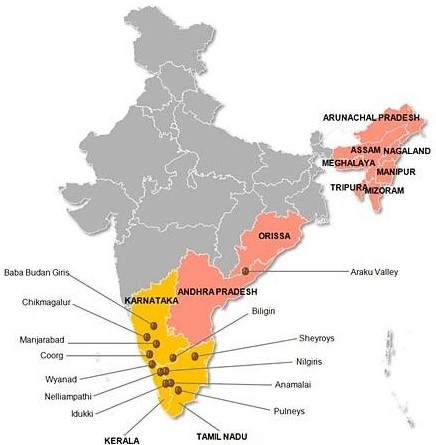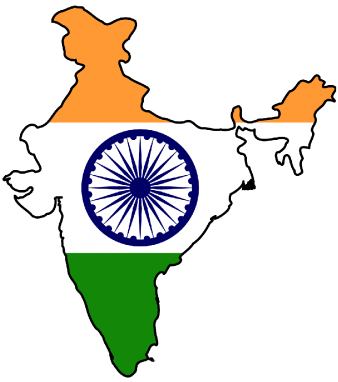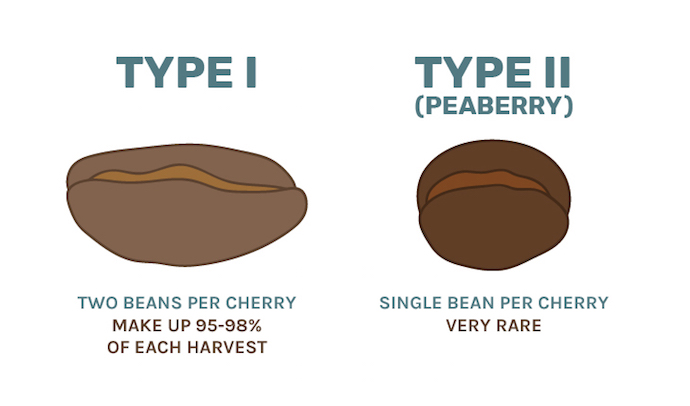Indian Elkhill Estate Peaberry
About India and it’s Coffee Production
Coffee production in India is dominated in the hill tracts of South Indian states, with Karnataka accounting for 71%, followed by Kerala with 21% and Tamil Nadu (5% of overall production with 8,200 tonnes). Indian coffee is said to be the finest coffee grown in the shade rather than direct sunlight anywhere in the world. There are about 250,000 coffee growers in the country; 98% of them are small growers. As of 2009, Indian coffee made up just 4.5% of the global production. Almost 80% of Indian coffee is exported; 70% is bound for Germany, Russia, Spain, Belgium, Slovenia, United States, Japan, Greece, Netherlands and France. Italy accounts for 29% of the exports. Most of the export is shipped through the Suez Canal.
Coffee is grown in three regions of India with Karnataka, Kerala and Tamil Nadu forming the traditional coffee-growing region, followed by the new areas developed in the non-traditional areas of Andhra Pradesh and Odisha in the eastern coast of the country and with a third region comprising the states of Assam, Manipur, Meghalaya, Mizoram, Tripura, Nagaland and Arunachal Pradesh of Northeastern India, popularly known as “Seven Sister States of India”.
Indian coffee, grown mostly in southern states under monsoon rainfall conditions, is also termed “Indian monsooned coffee”. The two well-known species of coffee grown are the Arabica and Robusta. The first variety that was introduced in the Baba Budan Giri hill ranges of Karnataka in the 17th century was marketed over the years under the brand names of Kent and S.795.
India is in the seventh line of the overall ranking in terms of exports and the third among Asian countries (after Vietnam and Indonesia). Statistical calculations show that more than 800 million dollars received by the country in this sector of the economy are not the limit. Export revenue is expected to increase over the next five years.
Where does the Indian Elkhill Estate Peaberry come from?
At present, the Elk Hill Group consists of 8 Estates in the region of Coorg, totalling 927 hectares of planted coffee (320 ha. for Arabica crop and 607 ha. for Robusta crop) and produces about 1000 tonnes of clean coffee per year, on average, out of which 50 tonnes is organically cultivated coffee. The Estate has an in-house coffee curing facility, which ensures that the coffee is properly processed and does not lose its identity.
Elk Hill is approx. 3500 ft MSL (1050 meters) with undulating terrain, with temperatures, ranges between a Min of 12 deg C to a Max of 34 deg C and an average rainfall of 1400 to 1500 mm annually.


What is Peaberry?
Peaberry, known in Spanish as caracolillo, meaning “little snail”, because of its more rounded shape, is a natural mutation of a coffee bean within the cherry. Normally the fruit (“cherry”) of the coffee plant contains two seeds (“beans”) that develop with flattened facing sides, but sometimes only one of the two seeds is fertilized, and the single seed develops with nothing to flatten it. This oval (or pea-shaped) bean is known as peaberry. Typically around 5% of all coffee beans harvested have experienced this peculiarity. Peaberry beans are hand-sorted from the crop. Peaberry beans are complex and full of flavour.

Tasting Notes for Indian Elkhill Estate Peaberry
| Country | India |
| Screen Size / Grade | Peaberry (PB) |
| Bean Appearance (green) | Clean garbled |
| Acidity | Medium- good |
| Body | Medium – Intense |
| Bag Size | 60kg |
| Harvest Period | November – March |
| Description | [insert] Noted for its higher level of acidity and intensity. |
| Tasting Notes | Fine acidity, intense citrus sweetness with a deep raisin aftertaste. |
| Strength | |
| Processing Method | Processed, dried then ‘monsooned’ |
| Altitude | 1000 – 1900 MASL |
History of Coffee in India
Coffee growing has a long history that is attributed first to Ethiopia and then to Arabia (Yemen). The earliest history is traced to 875 AD according to the Bibliotheque Nationale in Paris, and the original source to Ethiopia (Abyssinia) from where it was brought to Arabia in the 15th century.
In the Indian context, coffee-growing started with an Indian Muslim saint, Baba Budan, who, while returning from a pilgrimage to Mecca, smuggled seven coffee beans (by hiding them in his beard) from Yemen to Mysore in India. He planted them on the Chandra Drona Giri (1,829 metres (6,001 ft) (‘Giri’ means “hill”) in the Chikkamagaluru district. It was considered an illegal act to take the green coffee seed out of Arabia. As number seven is a sacrosanct number in the Islamic religion, the saint’s act of carrying seven coffee beans was considered a religious act. This was the beginning of the coffee industry in India, and in particular, in the then state of Mysore, now part of the Karnataka State. This was an achievement of considerable bravery of Baba Budan considering the fact that Arabs had exercised strict control over its export to other countries by not permitting coffee beans to be exported in any form other than as in a roasted or boiled form to prevent germination.
Systematic cultivation soon followed Baba Budan’s first planting of the seeds, in 1670, mostly by private native Indian owners and the first plantation was established in 1840 around Baba Budan Giri and its surrounding hills in Karnataka. It spread to other areas of Wynad (now part of Kerala), the Shevaroys and Nilgiris in Tamil Nadu. With British colonial presence taking strong roots in India in the mid 19th century, coffee plantations flourished for export. The culture of coffee thus spread to South India rapidly.
Initially, Arabica was popular. However, as a result of serious infestation caused to this species by coffee rust, an alternative robust species of coffee, appropriately named robusta and another hybrid between Liberia and Arabica, a rust-tolerant hybrid variety of Arabica tree became popular. This is the most common variety of coffee that is grown in the country with Karnataka alone accounting for 70% of the production of this variety.
In 1942, the government decided to regulate the export of coffee and protect the small and marginal farmers bypassing the Coffee VII Act of 1942, under which the Coffee Board of India got established, operated by the Ministry of Commerce and Industry. The government dramatically increased its control of coffee exports in India and pooled the coffees of its growers. In doing so, they reduced the incentives for farmers to produce high-quality coffee, so quality became stagnant.
Over the last 50 years, coffee production in India has grown by over 15 per cent. From 1991, economic liberalisation took place in India, and the industry took full advantage of this and cheaper labour costs of production. In 1993, a monumental Internal Sales Quota (ISQ) made the first step in liberalising the coffee industry by entitling coffee farmers to sell 30% of their production within India. This was further amended in 1994 when the Free Sale Quota (FSQ) permitted large and small scale growers to sell between 70% and 100% of their coffee either domestically or internationally. A final amendment in September 1996 saw the liberalisation of coffee for all growers in the country and the freedom to sell their produce wherever they wished.
Interested in some Indian Elkhill Estate Peaberry?
Visit our Peaberry page or Espresso Bar to buy a bag of our Indian Elkhill Estate Peaberry.
